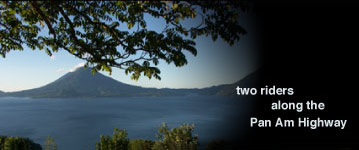
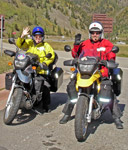
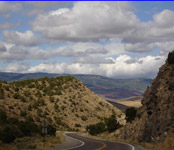
view corresponding gallery | previous entry | next entry
entry 17: honduras to nicaragua 03/04/06
We were up and on the road by 7:30 in an attempt to beat the heat and to reach the El Salvador/Honduras border before the crowds - we had heard that this might be the most complicated crossing of all Central American borders. The previous evening we had counted our money to be converted at the border to Honduran lempiras (at this point I would like to thank all of our family members who contributed helpful hints on how to do basic math). This time the conversion was pretty easy as the exchange rate was about 18.9 lempiras to the dollar.
The exit from El Salvador went quickly, requiring only two copies of our El Salvador vehicle permits and passports (50 cents each) - but gaining entrance to Honduras took three hours. I watched as Lynne went from one office to another, each time stopping in between to make copies of documents. I believe her final count was 18 stops in various buildings in order to obtain permission for the bikes to enter the country (all this after getting through immigrations with our passports). Her account was something like this:
First office – fill out bike entry paperwork (in Spanish, of course);
Second office, pay $10 each for entry paperwork;
Find money-changer because second office only takes only US$ and I have none;
Back to second office with correct currency;
Head to bank to pay $30 each for vehicle permits – visit two windows and speak with three people to complete transaction;
Third office for official stamp on vehicle permits – office closed as official is getting a haircut – I am asked to wait an hour;
Beg/cajole 14 other people to put the damn seal on our paperwork – after 20 minutes I had success;
Head to photocopy office for 2 copies each of the 10 pieces of paper I have accumulated so far;
To Tom (guarding the bikes) as I did not have his drivers license and needed to photocopy it;
Back to photocopy place – it was now closed;
Find new photocopy place – copy license;
Fourth office – fill out more vehicle paperwork and receive third official stamp;
Back to second photocopy place for copies of bike titles needed by fourth office;
Back to fourth office with necessary copies – official has left his office. Chase official down for 4th official stamp;
Pay the border guide for his help - $5 – most helpful in finding copy stores
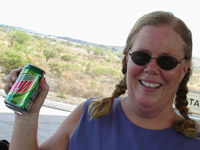 |
| Dew Time! |
Border crossing is big business for the Honduran government and for Canon and Xerox sales. The two documents you finally end up with have a total of four stamps and six signatures. Each stamp is placed on the documents by different individuals. I truly believe they generate more documents than are needed just because it means another four people will have a job. The best though, was the one official who went to get a haircut. Wow, who would have thought that an international border would shut down because some guy couldn’t find a barber after work hours? Lynne had been walking around in riding gear in 95° weather for almost three hours and would have none of it. She invoked the power of the red-head and found a helpful female border official who stamped our documents and got us moving a little quicker. Lynne’s hard work was rewarded at the next gas stop where she found a single can of ice cold Mountain Dew - what she considers the best beverage ever produced and impossible to find since leaving the states. God works in mysterious ways.
The bikes continue to run well and start every time we hit the road. Almost no oil has been consumed and in fact they have used less than half a quart of oil between the two bikes over the last 6,000 miles. We continue to put regular grade gas into the tanks and still average 60 to 65 miles per gallon. My “CyclePump” electric air pump had stopped working so I purchased a $3 hand pump at a bicycle shop for emergencies. A few days later I opened up the CyclePump and found a loose screw on top of the compression cylinder. An easy fix and it is nice to check and inflate the tires when they are cool. The chains look good and the back sprockets show little wear after 12,000 miles. Chain Wax seems to be doing a good job of lubricating and without making a mess down there. The tires still look fairly good but we will probably get a new set in Ecuador. Glad to report that no more parts have fallen off or failed since the "road wars" in Guatemala.
On into Honduras - the southern part of Honduras is very narrow - the distance from border to border between El Salvador and Nicaragua is only 85 miles. The country side is mostly dry stands of grass or hay with an occasional shrub bush thrown in along the highway. I am quite surprised by the arid appearance of the land - I can't say if it is because we are visiting during the dry season or if it is always like this. Before this trip I had this picture in my mind of lush green vegetation everywhere south of Mexico. More often than not the land reminds us of Wyoming or Montana.
We made our one stop in Honduras the town of Choluteca. We stayed at a pleasant hotel just outside of this small town but within walking distance to the town square. While doing our evening shopping I noticed how inexpensive food and beverages were getting to be. Beer is 80 cents a bottle and water is 15 cents a bag. Buying water in a bag (usually 400 ml or about a pint) has become very common and it produces less plastic waste. You just can’t set it down after you use your teeth to puncture a hole in it!
One afternoon, while sitting around the hotel patio trying to make my way through a local newspaper, I was approached by a fellow wearing camouflage pants and shirt. It turned out he was down here with his son and about 10 other guys to hunt doves. I grew up hunting ducks and pheasants so I thought I knew a little about what he was doing. It turned out that hunting down here is done a little differently. The group goes out twice a day, once at 5:30 in the morning for about 3 hours and then again at 3 p.m. until darkness at 6 p.m. Two hunting guides go out with the group to find the best bird areas and each hunter has two “helpers” who load all of there gear, carry their guns and beverages to the hunting area and then set up chairs for the guys to sit on while waiting for the doves to fly overhead. The hunter has only one job. That is to lift the shotgun and pull the trigger. I think these guys were more into partying at the hotel at night than actually hunting - but either way they seemed to be enjoying themselves.
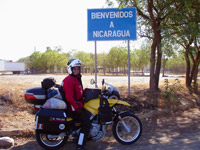 |
| Another border crossing - they seem to be coming fast and furious these days! |
By the end of our three days we were ready to tackle another border, this one crossing into Nicaragua at the town of Guasaule. Leaving Honduras was fairly easy. Entrance into Nicaragua was another 2½ hour paper chase. The border behind us, we rode into Nicaragua and the wind picked up immediately - blowing in gusts from 20 to 40 mph from the northeast. That same wind followed us into Costa Rica - word on the street is that this wind is created by the air moving over the mountain range that splits the center of Central America. It made for interesting moments when you were either passed by or were passing a semi - those big trucks created their own mix of wind/no-wind areas. The roads started out mostly dirt with some hard asphalt thrown in but neither Lynne nor I complained too much after some of the back roads we had been on previously. We made fairly good time and ended up in Managua in several hours. We stayed a few days to check out the town and relax.
Managua sits by a large lake of the same name which gives the whole city a gray background. It might have been the whitecaps on the water, or it's indescribable shade of brown, but I have to say that Lake Managua is the meanest looking body of water I have ever seen. The city itself is split into two parts, the old section by the lake and the new section which is located several miles away and over a hill. We stayed somewhere between the two, near a nice shopping mall and some good restaurants. Had some tasty Chinese food for the first time in a long time.
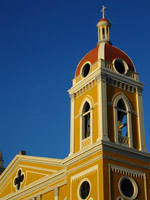 |
| A beautiful church on the square in Granada, Nicaragua |
Back on the road and continuing south, we decided to spend a few days in Granada. After an unintentional detour through the backside of the town’s market (backsides of local markets are filled with raw garbage – rotting veggies and fruits, plus all of the trash containers that are always overflowing, which means you are driving over crap) we popped out at the town square. Granada’s central park is very European looking and quite clean. We parked our bikes in the shade of one of the great looking hotel/restaurants and were immediately invited to sit down and have a cold one with Mary and Joe, a couple from Oregon that happened to be sitting at the outdoor cafe. These two fantastic souls knew quite a bit about the town and gave us a quick list of where to look for lodging. All of the places they suggested were great but none had parking for our bikes. After several hours of looking, Lynne finally found a hotel about four blocks east of the main square called Hotel Cocibolca II. They agreed to let us park inside their hotel IF we could get the bikes over two curbs. The guys at the Cocibolca found some scrap 2x4’s and we rode the bikes up and into their courtyard, right next to their wine rack. This place was reasonably priced at $39 and the rooms were comfortable.
Grenada was a great place to visit and we did a few tours while staying there - one being to a local artisans market in Masaya and the other a boat ride around Lake Nicaragua, which I found to be more like the fresh water lakes in the states - murky, but fairly clean and calm. We really enjoyed the lake tour as it wound through islands that were created by volcanic activity many years ago. The shopping tour to Masaya was…mostly Lynne’s thing. We had some great meals in Granada as well, one with Mary and Joe who had some great travel tips on places we would soon be headed to, and one at in a very quiet garden setting called Dona Conchis – a really romantic courtyard and great food. We highly recommend this place for lovers of every age!
The next day we ran into a KLR650 in front of Hospidaje Central and went inside looking for it's rider. We found Hank, a very nice biker from California who is headed the same direction we are – south. It was great to share a beer and stories of life on the road. Our travel schedules vary a bit, but we will try to meet up with him later, perhaps Panama or Ecuador.
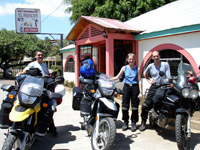 |
| Meeting up with Angela and Axel - touring the Americas all the way from Germany! |
The weather continued its warm, dry pattern as we headed out again toward the next border. On the way south we spotted a big bike with two nice looking helmets and luggage and knew they had to be fellow long-range travellers! We pulled a U-turn and they did as well. Halfway back we met up with Axel and Angela from Germany. They were making a day trip on the ferry to Ometepe Island on Axel's Africa Twin - and had left Angela's Transalp at their hotel in Grenada. Their trip began in South America (after flying their bikes from Germany) and they are headed north. Once again we were thrilled to share insights of the roads behind us, and they had great information for us about air-shipping our bikes to Ecuador. They are also documenting their travels via a webpage, but unfortunately for us English speakers, it is in German! Hopefully we will catch up with them again when we arrive in Europe this fall. After Angela and Axel left to catch their ferry, we decided to spend the night in a coastal town a bit further south called San Juan del Sur. The town had great sunset-view bars and restaurants - and the biggest lobsters we've seen on a dinner plate.
The ride out the next day was early again as we prepared to cross our fourth border in two weeks. I don’t know how to describe the low-level tension that border crossings can bring. We have had relatively good luck so far - so maybe it is just the possibility of losing a passport or bike title, or not obtaining all of the necessary paperwork- that builds a knot in your stomach from the minute you wake up until you're through the border maze. This time the crossing is into Costa Rica, and we have received great reviews about this country from our niece Nancy and her husband Andy who lived and worked down there a couple of years ago. We are looking forward to doing some adventure tours and plan on NOT crossing a border for a while.
From Lynne
I have to smile at how many times the concept of “perspective” has been thrown at me on this trip. An example. As Tom mentioned above, the cross-winds in this area have been pretty fierce. So as we are trolling down the highway at a pretty good clip, I’m at about a 45° angle and struggling to keep the bike headed in a straight line – and I’m sort of gritching to myself about how tough it is to keep these whales on the road. So then I come upon a woman riding a pretty-well beat up BICYCLE along this same road – struggling a bit as well. Not only is she exerting a great effort to keep her bike upright, she is doing it one-handed, because she is holding a 35-pound toddler with her other arm! Like I said – perspective.
I have found most borders so far to be fairly straightforward to cross – usually a very short process to get ourselves into the country and then a more detailed process to gain entrance for the bikes. If you have some command of the Spanish language, I would usually not recommend paying a border guide for their assistance. The exception to this advice would be Honduras. This process was a commercial for Rolaids even with a border guide – had I attempted it myself I would probably be making Christmas plans with the locals. Also – try your best not to arrive anywhere near the lunch hour - which I figure is anywhere between 11am and 3pm.

Copyright © 2005 All content and photography are the property of Tom and Lynne Gefre.
Contact us if interested in publishing or reusing any material.